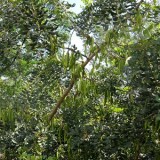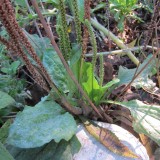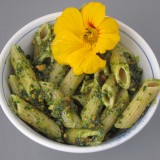Sorry, we don’t have a recipe for this, because we always wing it when it comes to pesto–even Erik, who is recipe dependent. You too can make it without a recipe.
Pesto is simply a blending of 5 main ingredients, which can vary widely according to season, availability and taste:
1) an aromatic herb, or blend of herbs (traditionally basil, but we use chives, parsley, mint, arugula and here, nasturtium flower–basically anything with a strong flavor. This can be stretched with some spinach or nettles for a milder flavor.)
2) a nut of some sort, toasted preferably
3) good quality shredded Parmesan cheese
4) good quality olive oil
5) raw or roasted garlic
You throw all these things in a blender, or go old school and mash them with a mortar and pestle. The proportions are intuitive. It’s hard to make bad pesto as long as your ingredients are good. Less cheese and nuts yields a lighter pesto. Less herb and more cheese and nuts makes a richer pesto. Less garlic yields a milder pesto. We use maybe 2 raw cloves per batch. It’s all good. Process the dry ingredients first, then add oil bit by bit to make a paste. Some people make a smooth paste, we leave nut chunks in. Add salt and pepper to taste.
Serve pesto over hot pasta, or spoon it into soup for flavor, or dip veggies in it, or thin it down and drizzle it over cooked veggies, or spread it on toasted bread, or eat it off the spoon…










Thanks for the “recipe” and tips. Personally, I prefer to eat a bowlful while I wait for pasta to boil. I never remember to put the pasta on. Then, I go heavy on the pesto. I have friends who will love this. Who takes these pictures? My closeups end up looking distorted. I have to take a picture and crop it severely to get a picture anything nearly this good.
Yum! And beautiful!
I had no clue that you eat Nasturtium flowers.
the two flavors for non-basil pesto that i love are: sage (with pinenuts) and celery leaves – i mean the green leaves on top of celery stalks – (w. walnuts or pine nuts). both can be quite strong so i add some parsley to make it milder.
I bet it tastes as good as it looks. I love nasturtiums.
Whoa. Dying to know what this tastes like? I’ve had a few nasturtium flowers in salad but can’t remember how they would taste in this amount, especially mixed with pistachios?! I’m thinking the leaves would also make an awesome spicy spread for some sandwiches….
Interesting…what does it taste like?
A book I’m reading mentioned nasturtiums. I’d already heard that the pickled pods can replace capers in recipes, but I didn’t know the petals were edible too – the book didn’t have a gorgeous pesto recipe either LOL
So I looked up nasturtium recipes the other day and found stuffed nasturtium leaves – they looked just like stuffed grapeleaves dish. I am SO buying nasturtium seeds next time I’m out ^_^
MMM… that sounds and looks so delicious. I love the peppery taste of nasturtiums.
Re: the questions about taste:
To me all parts of the nasturtium taste similar. The name means “nose tickler” — and it’s definitely spicy/peppery, but not “hot” spicy, and perhaps a tiny bit musty. It is, to some extent, an acquired taste. But I’ve had kids raised with it sit in my yard and eat the leaves off the bushes.
The flowers are a little sweeter that the leaves, and more tender. The resulting pesto is warm, spicy and “nose tickling.”
@Parsimony: Erik took the pictures, and I think he’d say it’s all about the camera. We’ve got a little Cannon digital and it just seems hard pressed to take a bad picture, even when I’m using it!
Your nasturtiums look beautiful, and the pesto sounds very unique. I’m trying for the second year to grow nasturtium. They come up grand, then they start to get yellow, then they die before flowering. My nasturtiums are just starting to turn yellow now. What can I do? I live in a hot, humid climate and water them faithfully every morning.
@Becky: Hmm. Gardening advice is very local. I can only guess. Our climate is not humid, but we have mild winters. So I plant nasturtium in the fall (it plants itself, really, from all the seeds it drops). This means it gets a good start in the cool, rainy weather of our winter, then blooms when it warms up, around March. It turns yellow and dies as soon as the sun gets intense, whether or not it’s watered. As of now, June, I only have a couple patches of it left in deep shade.
So, I don’t know what your winters are like, but maybe you could try to plant it earlier. As early as possible. It sounds like it’s getting heat baked. It really doesn’t like heat. I think of nast. as a quintessential Northern California plant. It loves mildness. You could also try planting it in the shade.
Keep your eye out for it in your area. Where do you see nice patches? When? Nasturtium is essentially a weed. If you can figure out its natural cycle in your area, try to copy it.
Pingback: Nasturtium Powder | Root Simple
Pingback: Nasturtium Leaf Pesto | Root Simple
Pingback: Nasturtium Leaf Pesto « Content Curated By Darin R. McClure & a few photos
What seriously moved you to post “Nasturtium Flower and Pistachio Pesto:
a story in pictures | Root Simple”? I actuallyhonestly liked
the post! Thanks a lot -Lilliana
Pingback: Lunch With Friends – Elizabeth Marro's Blog
Try using Nasturtium pesto with garlic on a bread,as in garlic& nasturtium bread.It is so delicious.
Pingback: Lunch With Friends | ELIZABETH MARRO